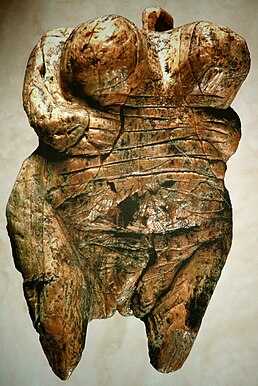
Back Prehistoriese kuns Afrikaans فن ما قبل التاريخ Arabic فن بدائى ARZ İbtidai incəsənət Azerbaijani Першабытнае мастацтва Byelorussian প্রাগৈতিহাসিক শিল্পকলা Bengali/Bangla Paleolitska umjetnost BS Art prehistòric Catalan ھونەری پێش مێژوو CKB Umění pravěku Czech
| History of art |
|---|
In the history of art, prehistoric art is all art produced in preliterate, prehistorical cultures beginning somewhere in very late geological history, and generally continuing until that culture either develops writing or other methods of record-keeping, or makes significant contact with another culture that has, and that makes some record of major historical events. At this point ancient art begins, for the older literate cultures. The end-date for what is covered by the term thus varies greatly between different parts of the world.[a]
The earliest human artifacts showing evidence of workmanship with an artistic purpose are the subject of some debate. It is clear that such workmanship existed 40,000 years ago in the Upper Paleolithic era, although it is quite possible that it began earlier. In September 2018, scientists reported the discovery of the earliest known drawing by Homo sapiens, which is estimated to be 73,000 years old, much earlier than the 43,000 years old artifacts understood to be the earliest known modern human drawings found previously.[2]
Engraved shells created by Homo erectus dating as far back as 500,000 years ago[3] have been found, although experts disagree on whether these engravings can be properly classified as 'art'.[4] From the Upper Paleolithic through to the Mesolithic, cave paintings and portable art such as figurines and beads predominated, with decorative figured workings also seen on some utilitarian objects. In the Neolithic evidence of early pottery appeared, as did sculpture and the construction of megaliths. Early rock art also first appeared during this period. The advent of metalworking in the Bronze Age brought additional media available for use in making art, an increase in stylistic diversity, and the creation of objects that did not have any obvious function other than art. It also saw the development in some areas of artisans, a class of people specializing in the production of art, as well as early writing systems. By the Iron Age, civilizations with writing had arisen from Ancient Egypt to Ancient China.
Many indigenous peoples from around the world continued to produce artistic works distinctive to their geographic area and culture, until exploration and commerce brought record-keeping methods to them. Some cultures, notably the Maya civilization, independently developed writing during the time they flourished, which was then later lost. These cultures may be classified as prehistoric, especially if their writing systems have not been deciphered.
- ^ A. T. L. 1967, p. 95.
- ^ Cite error: The named reference
NYT-20180912was invoked but never defined (see the help page). - ^ "Homo erectus at Trinil on Java used shells for tool production and engraving". Nature.
- ^ "Shell 'art' made 300,000 years before humans evolved – New Scientist". New Scientist.
Cite error: There are <ref group=lower-alpha> tags or {{efn}} templates on this page, but the references will not show without a {{reflist|group=lower-alpha}} template or {{notelist}} template (see the help page).

